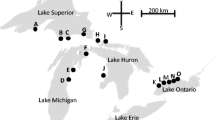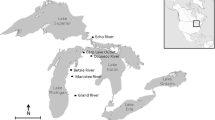Abstract
The sea lamprey, Petromyzon marinus, is a harmful invader of the Laurentian Great Lakes. The odor emitted by larval lampreys resident to streams attracts migrating adults to high quality spawning habitats. Three components of the larval pheromone have been identified and tested in laboratory settings: petromyzonol sulfate, petromyzosterol disulfate, and petromyzonamine disulfate. Here, we report the first field test of six mixtures of synthetic versions of these pheromone components, and we compare lamprey responses to these with those elicited by the complete larval odor in a natural stream. Exposure to larval odor both increased upstream movement and attracted migrants into the portion of a channel containing the odor. No tested combination of synthetic pheromone components proved similarly attractive. These findings suggest the existence of unknown additional components of the pheromone that await discovery and are likely necessary if the pheromone is to be useful in management of this pest. Further, we hypothesize that the complete pheromone mixture is necessary to attract migrants into spawning habitat at the conclusion of the migration, whereas a partial pheromone may be effective at the transition from lake to stream when natural factors both dilute and alter the ratio of components from that actually emitted by sea lamprey larvae.




Similar content being viewed by others
References
Allison, J. D. and Carde, R. T. 2008. Male pheromone blend preference function measured in choice and no-choice wind tunnel trials with almond moths, Cadra cautella. Anim. Behav. 75:259–266.
Atkinson, N. K. and Joy, M. K. 2008. Response of Gobiomorphus hubbsi (bluegill bully) to odours of conspecific fish In the presence of natural stream odours: does habitat have an influence? N.Z. J. Mar Freshwater Res 42:173–180.
Bjerselius, R., Li, W., Teeter, J. H., Seelye, J. G., Johnsen, P. B., Maniak, P. J., Grant, G. C., Polkinghorne, C. N., and Sorensen, P. W. 2000. Direct behavioral evidence that unique bile acids released by larval sea lamprey (Petromyzon marinus) function as a migratory pheromone. Can. J. Fish. Aquat. Sci. 57:557–569.
Carde, R. T. 2005. Bioassays for insect attractants, to what end: aiding chemical identification, measuring adaptive value or verifying orientation mechanisms? pp. 203–206, in L. P. J. J. Noldus, F. Greico, L. W. S. Loijens, and P. H. Zimmerman (eds.), Proceedings Measuring Behavior 2005. Noldus Information Technologies, Wageningen, Netherlands.
Endler, J. A. 1992. Signals, signal conditions, and the direction of evolution. Am. Nat. 139:S125–S153.
Evenden, M. L., Judd JR, G., and Borden, J. H. 1999. Pheromone-mediated mating disruption of Choristoneura rosaceana: is the most attractive blend really the most effective? Entomol. Exp. Appl. 90:37–47.
Fine, J. M. 2006. Isolation, identification, and biological characterization of the sea lamprey (Petromyzon marinus) migratory pheromone. Ph.D. dissertation. University of Minnesota, Twin Cities.
Fine, J. M. and Sorensen, P. W. 2008. Isolation and biological activity of the multi-component sea lamprey migratory pheromone. J. Chem. Ecol. 34:1259–1267.
Fine, J. M. and Sorensen, P. W. 2010. Production and fate of the sea lamprey pheromone. Fish Physiol. Biochem. 36:1013–1020.
Fine, J. M., Vrieze, L. A., and Sorensen, P. W. 2004. Evidence that Petromyzontid lampreys employ a common migratory pheromone which is partially comprised of bile acids. J. Chem. Ecol. 30:2091–2110.
Fine, J. M., Sisler, S. P., Vrieze, L. A., Swink, W. D., and Sorensen, P. W. 2006. A practical method for obtaining useful quantities of pheromones from sea lamprey and other fishes for identification and control. J. Great Lakes Res. 32:832–838.
Gore, J. A. 1996. Discharge measurements and streamflow analysis, pp. 53–74, in F. R. Hauer and G. A. Lamberti (eds.), Methods in Stream Ecology. Academic, San Diego, CA.
Haslewood, G. A. and Tokes, D. L. 1969. Comparative studies of bile salts: Bile salts of the sea lamprey, Petromyzon marinus. J. Biochem. 114:179–184.
Hoye, T. E., Dvornikovs, V., Fine, J. M., anderson, K. R., Jeffrey, C. S., Muddiman, D. C., Shao, F., Sorensen, P. W., and Wang, J. 2007. Details of the structure determination of the sulfated steroids PSDS and PADS - new components of the sea lamprey (Petromyzon marinus) migratory pheromone. J. Org. Chem. 72:7544–7550.
Johnson, N. S. and Li, W. 2010. Understanding behavioral responses of fish to pheromones in natural freshwater environments. J. Comp. Physiol. 196(A):701–711.
Johnson, N. S., Yun, S. S., Thompson, H. T., Brant, C. O., and Li, W. 2009. A synthesized pheromone induces upstream movement in female sea lamprey and summons them into traps. Proc. Natl. Acad. Sci. USA 106:1021–1026.
Kibbey, C. E. 1995. Quantitation of combinatorial libraries of small organic molecules by normal-phase HPLC with evaporative light-scattering detection. Mol. Divers. 1:247–258.
Lewis, J. C. and McMillan, D. B. 1965. The development of the ovary of the sea lamprey (Petromyzon marinus, L.). J. Morphol. 117:425–466.
Li, W., Sorensen, P. W., and Gallaher, D. D. 1995. The olfactory system of migratory sea lamprey (Petromyzon marinus, L.) is specifically and acutely sensitive to unique bile acids released by conspecific larvae. J. Gen. Physiol. 105:569–587.
Li, W., Scott, A. P., Siefkes, M. J., Yan, H., Liu, Q., Yun, S. S., and Gage, D. A. 2002. Bile acid secreted by male sea lamprey that acts as a sex pheromone. Science 296:138–141.
Linn, C. E. and Roelofs, W. L. 1989. Response specificity of male moths to multicomponent pheromones. Chem. Senses 14:421–437.
Linn, C. E., Campbell, J. R., and Roelofs, W. L. 1987. Pheromone components and active spaces: what do moths smell and where do they smell it? Science 237:650–652.
Luehring, M. A., Wagner, C. M., and Li, W. 2011. The efficacy of two synthetized sea lamprey sex pheromone components as a trap lure when placed in direct competition with natural male odors. Biol. Invasions 13:1589–1597.
Madenjian, C. P., O’Gorman, R., Bunnell, R. L., Argyle, R. L., Roseman, E. F., Warner, D. M., Stockwell, J. D., and Stapanian, M. A. 2008. Adverse effects of alewives on Laurentian Great Lakes fish communities. N. Am. J. Fish Mgmt. 28:263–282.
Magurran, A. E., Irving, P. W., and Henderson, P. A. 1996. Is there a fish alarm pheromone? A wild study and critique. Proc. R. Soc. Lond. 263(B):1551–1556.
Polkinghorne, C. N., Olson, J. M., Gallaher, D. G., and Sorensen, P. W. 2001. Larval sea lamprey release two unique bile acids to the water at a rate which is sufficient to produce a detectable pheromonal plume. Fish Physiol. Biochem. 24: 15–30.
Quinn, F. H. 1978. Hydrologic Response Model of the North American Great Lakes. J. Hydrol. 37:295–307.
Shannon, C. E. 1949. Communication theory of secrecy systems. Bell Syst. Tech. J. 28:656–715.
Smith, S. H. 1970. Species interactions of the alewife in the Great Lakes. Trans. Am. Fish Soc. 99:754–765.
Smith, B. R. and Tibbles, J. J. 1980. Sea lamprey (Petromyzon marinus) in Lakes Huron, Michigan, and Superior—History of invasion and control. 1936–1978. Can. J. Fish. Aquat. Sci. 37:1780–1801.
Sorensen, P. W. and Hoye, T. E. 2007. A critical review of the discovery and application of a migratory pheromone in an invasive fish, the sea lamprey, Petromyzon marinus L. J. Fish Biol. 71(D):100–114.
Sorensen, P. W., Vrieze, L. A., and Fine, J. M. 2003. A multicomponent migratory pheromone in the sea lamprey. Fish Phys. Biochem. 28:253–257.
Sorensen, P. W., Fine, J. M., Dvornikovs, V., Jeffrey, C. S., Shao, F., Wang, J., Vrieze, L. A., anderson, K. R., and Hoye, T. R. 2005. Mixture of new sulfated steroids functions as a migratory pheromone in the sea lamprey. Nat. Chem. Biol. 1:324–328.
Sutton, T. M. and Bowen, S. H. 1994. Significance of organic detritus in the diet of larval lampreys in the Great Lakes basin. Can. J. Fish. Aquat. Sci. 51:2380–2387.
Teeter, J. 1980. Pheromone communication in sea lampreys (Petromyzon marinus): implications for population management. Can. J. Fish Aquat. Sci. 37:2123–2132.
Tremaine, R. J., Pollock, M. S., Friesen, R. G., Kusch, R. C., and Chivers, D. P. 2005. The response of prey fishes to chemical alarm cues: what recent field experiments reveal about the old testing paradigm. Chem. Sig. Vert. 10:328–333.
Trimble, R. M. and Marshall, D. B. 2008. Relative attractiveness of incomplete and complete blends of synthetic pheromone to male obliquebanded leafroller (Lepidoptera: Torticidae) moths in a flight tunnel and in apple orchards: implications for sex pheromone-mediated mating disruption of this species. Environ. Entomol. 37:366–373.
Twohey, M. B., Sorensen, P. W., and Li, W. 2003. Possible applications of pheromones in an integrated sea lamprey management program. J. Gt. Lakes Res. 29:794–800.
Vrieze, L. A. and Sorensen, P. W. 2001. Laboratory assessment of the role of a larval pheromone and natural stream odor in spawning stream localization by migratory sea lamprey (Petromyzon marinus). Can. J. Fish. Aquat. Sci. 58:2374–2385.
Vrieze, L. A., Bjerselius, R., and Sorensen, P. W. 2010. Importance of the olfactory sense to migratory sea lampreys Petromyzon marinus seeking riverine spawning habitat. J. Fish Biol. 76:949–964.
Vrieze, L. W., Bergstedt, R. A., and Sorensen, P. W. 2011. Olfactory-mediated stream-finding behavior of migratory adult sea lamprey (Petromyzon marinus). Can. J. Fish. Aquat. Sci. 68:523–533.
Wagner, C. M., Jones, M. L., Twohey, M. B., and Sorensen, P. W. 2006. A field test verifies that pheromones can be useful for sea lamprey (Petromyzon marinus) control in the Great Lakes. Can. J. Fish Aquat. Sci. 63:475–479.
Wagner, C. M., Twohey, M. B., and Fine, J. M. 2009. Conspecific cueing in the sea lamprey: do reproductive migrations consistently follow the most intense larval odour? Anim. Behav. 78:593–599.
Weissburg, M. J. 2011. Waterborne chemical communication: stimulus dispersal dynamics and orientation strategies in crustaceans, Part 2. pp. 63–83 in B. Thomas and T. Martin (eds.). Chemical Communication in Crustaceans. Springer Science.
Wyatt, T. D. 2003. Pheromones and Animal Behaviour. 1st edn. Chapter 2. Cambridge University Press, Cambridge, UK.
Acknowledgments
This study was funded by the Great Lakes Fishery Commission. We are grateful to the staff of the Hammond Bay Biological Station, the U.S. Fish and Wildlife Service Marquette Biological Station, and the Department of Fisheries and Oceans Canada Sea Lamprey Control Centre for providing experimental subjects and access to laboratory facilities. We thank Ed Hessler, Weiming Li, Michael Siefkes, and Sang Seon Yun for insightful discussions and assistance with interpretation of the 1H NMR and HPLC analyses of the synthetic pheromone components. We thank two anonymous reviewers for comments that improved the manuscript. We also thank Rob Katona, Sanjeev Mahabir, Tim St. Pierre, and Adam Thomas for assistance in the field.
Author information
Authors and Affiliations
Corresponding author
Rights and permissions
About this article
Cite this article
Meckley, T.D., Wagner, C.M. & Luehring, M.A. Field Evaluation of Larval Odor and Mixtures of Synthetic Pheromone Components for Attracting Migrating Sea Lampreys in Rivers. J Chem Ecol 38, 1062–1069 (2012). https://doi.org/10.1007/s10886-012-0159-x
Received:
Revised:
Accepted:
Published:
Issue Date:
DOI: https://doi.org/10.1007/s10886-012-0159-x




